Heading out the door? Read this article on the new Outside+ app available now on iOS devices for members! Download the app.
Kiri Gurd’s troubles started with a particularly rough childhood, one that instilled a deep fear of abandonment. From that ongoing fear grew a lifelong battle with anxiety. Everyday activities like hanging out with friends or going to bed at night would send the Boston University doctoral student’s mind racing, leaving her worried and afraid. At times, these episodes would balloon into full-fledged panic attacks. The attacks were disabling, but, says Gurd, “What really brought me to despair was the constant nervousness, inability to relax, and belief that people were thinking terrible things about me. It undermined my ability to experience joy.”
Some 40 million Americans over the age of 18 are afflicted with anxiety disorders in a given year, according to the National Institute of Mental Health. The American Psychiatric Association notes that these disorders are different from normal nervousness and include overwhelming feelings of panic and fear, uncontrollable obsessive thoughts, painful and intrusive memories, recurring nightmares, being easily startled, and muscle tension. Once anxiety takes hold, it can manifest in a variety of ways—from panic and obsessive-compulsive behaviors to posttraumatic stress, phobias, and generalized anxiety disorder.
Many people know what anxiety feels like, the way it controls the mind, produces achiness or nausea, and creates a sense of disconnect between mind, body, spirit, and the outside world. Under these conditions, relaxation is often a challenge; experiencing a sense of peace can be nearly impossible. But yogic breathing practices and asana sequences that slow the heart rate, drop blood pressure, and release muscles can help soothe an anxious mind. “When people are anxious, the sympathetic nervous system is revved up,” says Timothy McCall, MD, the author of Yoga as Medicine and medical editor for Yoga Journal. “Yoga says calming the breath calms the nervous system, and calming the nervous system calms the mind. A tense mind can lead to tense muscles, and relaxing the muscles can help relax the mind.”
It’s worked for Gurd, who has found a source of deep calm in her twice-weekly Iyengar Yoga classes and during her regular home practice. Though yoga hasn’t proved a cure-all, Gurd says she feels more grounded and relaxed with each practice. “When I practice, I can feel calmer,” she says, “like there’s a home inside me to go to, that all the safety and peace I need is inside, and that it will always be there for me.”
Left untreated, anxiety disorders are often disabling; the typical Western medical treatment includes psychotherapy and medication. Gurd sought help primarily from psychotherapists, who diagnosed her with generalized anxiety. Talk therapy sessions let her explore the psychological roots of her condition, but her yoga practice proved especially helpful in quieting the racing thoughts that kept her up at night. “I used to wake up ruminating about the day, and I’d worry as I fell asleep, but that really dissipated with yoga,” Gurd says. “Yoga allows me to not have an entirely cerebral response to anxiety. It offers a way out of my brain and into my body.”
Peace and Quiet
So how does it work? According to McCall, yoga relieves anxiety by inducing the relaxation response. First, active asana stimulates the sympathetic nervous system; then, more-calming poses activate the parasympathetic nervous system. The effect is a rare moment of quiet that is healing to the anxious mind. According to a 2007 study, researchers in Boston found that doing yoga increases the levels of GABA, or gamma-aminobutyric acid, a neurotransmitter that may help reduce anxiety.
A pilot study under way at the University of California, Los Angeles, is examining the effect of yoga on people who have generalized anxiety disorder. Heading the study is David Shapiro, a research psychologist at UCLA’s David Geffen School of Medicine. And though Shapiro, like any other careful researcher, will speak only minimally about his unpublished work, he concedes that the results so far have been promising. In the study, patients took part in a six-week series of classes designed by Iyengar Yoga senior teacher Marla Apt (who wrote the sequence featured here), in close consultation with B.K.S. Iyengar, the founder of Iyengar Yoga. The participants, many of whom were new to yoga, attended classes three times a week and answered a series of questionnaires about their emotional states before and after practicing. Even in that short time, Shapiro and Apt found a significant reduction in anxiety and depression and a marked increase in positive moods and overall energy.
In all of the poses, Apt worked with students to soften the neck and face. “With anxiety, the frontal forehead region becomes tense, and the facial features feel as though they’re tightened, concentrated, and pulled forward,” says Apt. “These poses allow the face to recede and the sense of concentrated tension to dissipate.”
In her asana sequence, Apt incorporated active but soothing inversions like Adho Mukha Svanasana (Downward-Facing Dog Pose); passive backbends like chair-supported Viparita Dandasana (Inverted Staff Pose), which open the chest without overstimulating the nervous system; and supported forward bends. Apt looked to centuries of yogic experimentation in relieving an anxious mind. Forward bends are key, she found, but many students struggle when an anxious mind turns doing the poses into a stressful chore. Senior Iyengar Yoga teacher Patricia Walden, who leads workshops on anxiety and depression, says, “Quiet poses can be threatening and cause restlessness, so I have [students] do an active practice: Warrior Poses, Sun Salutations, then supported backbends, supine poses, and forward bends.”
These poses also target the physical manifestations of anxiety. People suffering from anxiety often appear to be bracing against something, observes Walden. “They have a tight neck and shoulders, and eyes projecting forward in a sympathetic nervous system response.” That response means blood is moving from the internal organs to the arms and legs, while the heart rate increases and blood pressure rises.
State of Mind
Fundamental to treating anxiety with yoga is learning to observe the mind objectively. Known as svadhyaya in Sanskrit, such self-study can help you to note physical, emotional, and mental states in a neutral way. When you’re dealing with anxiety, svadhyaya can show you how to observe your emotional state rather than be swept away by it. When you can recognize incipient anxiety with awareness and attention, says Walden, “You’re able to pause before reacting, and then observe where the anxiety goes in the body: to the neck? the back? At best you can put yourself in an objective place in relationship to this thing that’s making you anxious, and then choose how to respond.”
Try it for yourself by watching any stress that may arise in a particular pose. Rather than identify with that stress, observe it as it arises and passes. With practice, you can retrain your body and mind to create new responses to anxiety-provoking situations. So instead of automatically panicking when things get difficult, the body and mind begin to find other options and pathways. What once was an inflexible, anxious state becomes more fluid. You might even discover that anxious feelings are impermanent and that, with practice, you can change them.
The self-study aspect of the practice was transformative for Jessica T., of Berkeley, California, in healing a severe anxiety disorder. In the summer of 2007, the 35-year-old began to worry about the safety of family members. Worst-case scenarios consumed her and left her feeling frighteningly disconnected from her body. Several times she internalized her worries so intensely that she felt as though she might fall and had to sit down during paralyzing panic attacks.
When Jessica sought therapy, she was diagnosed with anxiety and was strongly encouraged to use medication. She avoided the prescription because she was wary of the long-term consequences, but she began twice-weekly psychotherapy appointments, experimented with dietary changes, and became a regular at a Friday morning Anusara Yoga class. As she spent more time on her yoga mat, studying her responses to the poses and absorbing the yogic philosophy that her teacher shared, Jessica began to have insights about the malleability of her anxieties. “When you’re feeling anxious,” she explains, “you sometimes feel like nothing’s going to change.” But as she studied her habitual fears, Jessica slowly shifted her thinking patterns. “I began to see that everything is part of a transition. I would think, “‘I was a person with anxiety. But today I’m not. Tomorrow I’ll be something else.’ In the future, if it comes up again, I know that I got through it.”
As she cultivated the ability to watch her thoughts on the mat, she naturally developed an ability to be free of attachment to those that occurred off the mat. Yoga isn’t a magic bullet, she says, but it’s helped her immensely with her anxiety, and she is no longer in therapy. “It’s a gift that makes you think about who you are—and why you are who you are. Just because that’s you in that moment, it doesn’t have to be you for the rest of your life.”
With that revelation comes freedom from the fears that consume the mind. In fear’s place is the ability to be more present and to experience awareness in body and mind—even when anxiety begins to creep back in. As Kiri Gurd became more aware of her body’s real, in-the-moment needs, she began to think that medication might be useful. And it was. “The yoga did help substantially,” she says, “but it also helped me assess myself more honestly.”
After adjusting to her medication, Gurd found more joy in life—including her yoga practice, which continues to inspire her to slow down and practice self-study. “Sometimes I’ve lost track of how anxious I’ve become, or even how relaxed I may be,” Gurd says. “The way I feel in particular poses gets me back in touch with how I’m doing. A lot of my anxiety comes from not having an internal compass to guide me through my feelings.” Building that compass—that ability to more deeply sense her feelings and watch them as they shift throughout the day—offers Gurd a way to come back to her center, or ‘home,” as she calls it. “I’m not saying life is totally joyful,” she says, “but I’m tasting it.”
Yoga Practice Sequence
Editor’s Note: If you have severe anxiety, consult your doctor before trying this calming sequence.
1. Adho Mukha Svanasana (Downward-Facing Dog Pose), supported
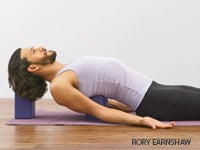
With your hands and knees on the floor, place a block under your chest. Straighten your legs and lift the pelvis up. Push the floor away to extend and lift the torso. Keeping your arms straight, release your neck and rest your head on the block. Adjust the height of the block or add a blanket to rest the head easily. Keep the arms and legs strong and the face soft. Hold for 2 minutes.
2. Adho Mukha Vrksasana (Handstand)
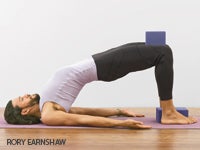
Place your hands a few inches away from a wall. From Adho Mukha Svanasana, walk the feet closer to the wall, lifting the hips. Raise one leg straight up toward the ceiling, and push off the other bent leg to kick up and take the feet to the wall into Handstand. Keep both arms straight and stretch the heels up the wall. Spread the palms and extend from the arms through the sides of the chest up to the feet. Lift your head slightly to look at the wall. Hold for up to 1 minute. If you can’t get into Handstand, try kicking up several times, working on taking the pelvis toward the wall as you kick up; then repeat Adho Mukha Svanasana.
3. Viparita Dandasana (Inverted Staff Pose), supported
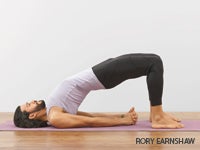
Sit backward through a folding chair, preferably one that has a large opening in the backrest so that you have ample space for your legs. Holding on to the sides of the top of the chair, lift and broaden the chest while lying backward over the seat. The edge of the chair seat should support you near the middle of the back. Rest the top of your head on a bolster or folded blankets. Straighten and extend the legs. Open the chest and move your arms in between the front legs of the chair to grasp the back legs of the chair. If you cannot straighten your legs, raise your heels onto blocks or some other support. Hold for 5 minutes.
To come out of the pose, hold near the top of the chair, bend your knees, put your feet flat on the floor, and keep your chest open as you pull yourself up. Once upright, stay for a few moments with your eyes closed.
4. Setu Bandha Sarvangasana (Bridge Pose), supported
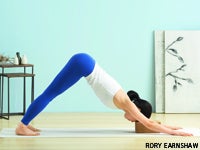
Keep the props set up as in the previous pose, but add a second chair for your feet and more support (a second bolster or more blankets) for your head. As in Viparita Dandasana, hold on to the top of the chair as you lie backward on the seat. Slide off the chair until your shoulders reach the bolster so that your shoulders and head are resting at the same level. Place your feet on the second chair and straighten your legs with the heels apart. Relax the abdomen and allow it to extend. Hold for 5 minutes, and then come out of the pose as you did in Viparita Dandasana.
5. Sarvangasana (Shoulderstand), variation

This blanket setup is different from the typical Shoulderstand. Here, the head is elevated and the back of the neck lengthens, which allows the face to recede and concentrated tension to dissipate.
To begin, roll up one blanket. Then make a thicker roll with two blankets. Open your mat against a wall and place the thin roll against the wall and the thicker roll about 1 foot away from the wall. Place a bolster lengthwise against the second roll.
Lie on the bolster, shoulders on the thick roll and your head on the thin roll. Bend your knees, lift your pelvis, and place your feet on the wall. Walk your feet up the wall and straighten your legs. The thin roll supports the back of the head so that the back of the neck lengthens between the two rolls. If the head touches the wall, move it closer to the bolster. Relax the arms, bend your elbows, and rest the back side of your hands on the floor.
Although you’ll feel a stretch in your neck, most of your weight should be on the shoulders. Your neck should feel relaxed. Do not push the back ribs toward the chest, as you might in other versions of Shoulderstand. Instead, allow the sternum to move away from your chin and the upper back to round slightly. Relax the temples and keep the jaw soft. At first, this variation may feel awkward. Practice it several times to experience the desired effect. If you can, hold for 5 minutes.
6. Paschimottanasana (Seated Forward Bend), supported
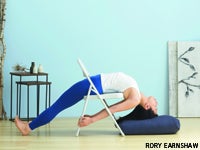
Sit in Dandasana (Staff Pose) with a folded blanket under the buttocks, and put a bolster lengthwise on top of the thighs. Place a folded blanket on top of the end of the bolster closest to your feet. Extend your torso forward over the legs, and catch the feet with your hands. Rest your forehead on the blanket and your abdomen on the bolster for 3 minutes. Use more support if the props aren’t high enough, or place a chair in front of you and prop the bolster against the seat of the chair.
7. Viparita Karani (Legs-up-the-Wall Pose), supported
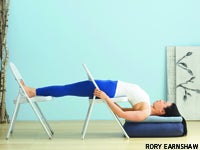
Stack a couple of folded blankets on top of a bolster near a wall. Put a block between the bolster and the wall and a blanket on the floor in front of the bolster for your head and shoulders.
Sit on the side of the bolster and roll your sacrum onto it, lifting your legs up the wall. Scoot yourself close to the wall so that the buttocks touch or come near the wall. Gently lower your shoulders and head to the floor. If you slide off the bolster, you can push yourself closer with your hands on the floor. Straighten your legs and press the thighs into the wall as you open your chest. Rest for 5 minutes. To come down, bend your knees, push your feet into the wall, slide away from the wall, and rest your back on the floor.
To Finish: Rest for 10 minutes, with eyes covered if you’d like, in Savasana (Corpse Pose).